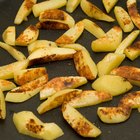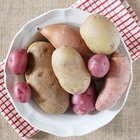
Potatoes have long been a favorite food of frugal cooks, because their versatility is matched only by their low cost and keeping qualities. Unfortunately, potatoes only store well until they're peeled or cut. Once their skin is broken, they quickly become brown and unusable. That's inconvenient if you'd like to shred potatoes in advance and freeze them for later use in hash browns, potato pancakes and similar recipes. Fortunately, you can minimize the browning process.
Why It Happens
Potatoes and other plant-based foods don't have a lot of ways to defend against being eaten. They can't run away or fight back physically, so they rely on chemical defenses. The pungent smell of onions and the searing bite of chili peppers are two obvious chemical defenses, but browning is more subtle. When potatoes are peeled or cut, enzymes in their cells are liberated that mix with outside oxygen and some of the phenolic compounds that give potatoes their flavor. That chemical reaction produces browned areas, which dissolve proteins and inflame tender membranes. This can deter many insect pests and their larvae from eating the potato.
What Slows the Reaction
The tendency to brown occurs in a number of widely eaten foods, from artichokes to apples and bananas. Cooks have long known ways to counter that reaction, but it took modern food science to understand why each technique works. For example, chilling potatoes before you shred them slows the browning process, because the enzymes that cause the reaction work more slowly when they're cold. Acidity has the same effect, and keeping oxygen away from the potatoes minimizes browning. Finally, cooking the potatoes even lightly deactivates the enzyme and prevents browning entirely.
Preparing Your Potatoes
To shred a quantity of potatoes with minimal browning, start by cooling your potatoes in either the refrigerator or a bowl of ice water. Have a second bowl handy; fill it with ice water and a hint of acidity from lemon juice or a commercial anti-browning powder. Shred your potatoes into the second bowl, so the water will shut out most of the oxygen and slow browning because of its cold and acidity. When you've shredded all the potatoes, drain them and plunge them into boiling water for 30 to 60 seconds. This step is optional and removes some of their starch -- necessary for many recipes -- but makes them largely impervious to browning.
Freezing Your Potatoes
Drain the shredded potatoes thoroughly in a colander, gently pressing out as much water as possible. Measure the potatoes into portions that match your favorite recipes, then pack them into individual heavy-duty freezer bags. Squeeze out as much air as possible, for the maximum possible shelf life. If you have a vacuum food sealer, use that instead for even better results. You can also use rigid freezer containers, though these don't exclude as much oxygen. For best results, press a sheet of plastic film wrap to the surface of the potatoes before you seal the lid.
Related Articles
Can You Peel Potatoes the Day Before ...
Why Does Lemon Juice Keep Potatoes From ...

The Best Potatoes For Shredded Hash ...

How to Sautee Potatoes

How to Shred Potatoes by Hand

How to Keep French Fries From Turning ...

How to Boil Cubed Potatoes to Pan Fry ...
How to Pressure Cook Medium Red Potatoes

What Happens to Bananas Dipped in Lemon ...
Can I Freeze Cubed Root Vegetables?

Can You Eat Peeled Potatoes After ...

How to Make a Foil Wrapped Potato

How to Heat Up Mashed Potatoes

What Is Oil Blanching?

How to Smoke Potatoes
How to Boil Potatoes So They Can Be ...

Do Frozen Potatoes Cook Well Once ...

Can You Over-Bake a Potato?

List of Different Types of Potatoes

What is Pomme Fondant?
References
- On Food and Cooking: The Science and Lore of the Kitchen; Harold McGee
Writer Bio
Fred Decker is a trained chef and prolific freelance writer. In previous careers, he sold insurance and mutual funds, and was a longtime retailer. He was educated at Memorial University of Newfoundland and the Northern Alberta Institute of Technology. His articles have appeared on numerous home and garden sites including GoneOutdoors, TheNest and eHow.
Photo Credits
Jupiterimages/Stockbyte/Getty Images